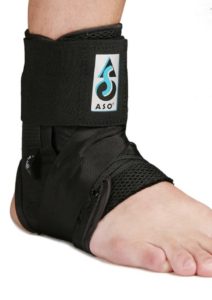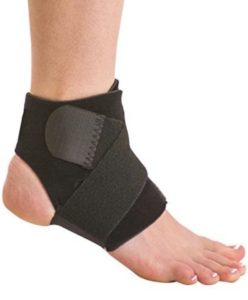. 2000 Oct;10(4):291-6.
doi: 10.1097/00042752-200010000-00012.
The effect of preventive measures on the incidence of ankle sprains
- PMID: 11086757
- DOI: 10.1097/00042752-200010000-00012
Abstract
Objective: To critically review the current data concerning the efficacy of preventive measures described in the literature, on the incidence of lateral ankle ligament injuries.
Data sources: MEDLINE, Sportdiscus, and EMBASE were searched for papers published between 1980 and December 1998. Keywords used in the search were “prevention” in combination with “ankle,” “ankle taping,” “ankle bracing,” “orthosis,” “shoes,” and “proprioception.” Additional references were reviewed from the bibliographies of the retrieved articles.
Study selection: A study was included if: 1) the study contained research questions regarding the prevention of lateral ankle ligament injuries; 2) the study was a randomized controlled trial, a controlled trail, or a time intervention; 3) the results of the study contained incidence rates of lateral ankle ligament injuries as study outcome; and 4) the study met the cut-off score set for quality.
Data extraction and synthesis: Two reviewers reviewed relevant studies for strengths and weaknesses in design and methodology, according to a standardized set of predefined criteria. Eight relevant studies met the criteria for inclusion and were analyzed.
Main results: Overall, all studies reported a significant decrease in incidence of ankle sprains using the studied preventive measure. There was a great variety in methodology and study design between the eight analyzed studies, and every study had one or more drawbacks. Therefore, between studies only general results could be compared.
Conclusions: The use of either tape or braces reduces the incidence of ankle sprains. Next to this preventive effect, the use of tape or braces results in less severe ankle sprains. However, braces seem to be more effective in preventing ankle sprains than tape. It is not clear which athletes are to benefit more from the use of preventive measures: those with or those without previous ankle sprains. The efficacy of shoes in preventing ankle sprains is unclear. It is likely the newness of the footwear plays a more important role than shoe height in preventing ankle sprains. Proprioceptive training reduces the incidence of ankle sprains in athletes with recurrent ankle sprains to the same level as subjects without any history of ankle sprains.
CORE Physical Therapy in Omaha Explains…
By Mark Rathjen PT DPT CSCS
CORE Physical Therapy and Sports Performance, PC
The Above article states “The use of either tape or braces reduces the incidence of ankle sprains. Next to this preventive effect, the use of tape or braces results in less severe ankle sprains. However, braces seem to be more effective in preventing ankle sprains than tape. It is not clear which athletes are to benefit more from the use of preventive measures: those with or those without previous ankle sprains. The efficacy of shoes in preventing ankle sprains is unclear. It is likely the newness of the footwear plays a more important role than shoe height in preventing ankle sprains. Proprioceptive training reduces the incidence of ankle sprains in athletes with recurrent ankle sprains to the same level as subjects without any history of ankle sprains.”
What does this mean?
Brace help more than taping to reduce ankle sprains, but they both help. They bother reduce the severity of sprains when worn as well. Shoes, once again do not show any correlation with ankle sprain prevention.
As stated in previous research and our own blogs… Ankle sprain rates are reduced by balance and proprioceptive training.
Ok, so what does this mean?
Athletes should wear ankle braces, especially if they have a history of ankle sprains. Also a qualified therapist should be able to develop and implement a full proprioceptive training program that will also further reduce the rates of ankle sprains.
At CORE Physical therapy in Omaha Nebraska, we specialize in athletes. We specialize in treatment. We specialize in prevention. We specialize in getting you back to better than ever.
C.O.R.E. Physical Therapy and Sports Performance PC,
At CORE Physical Therapy in Omaha, We specialize in the treatment of athletes. We have worked with athletes for a combined 30 years.
This is who are, This is what we do.
Owned and Operated
by
Dr. Mark Rathjen and Dr. Claire Rathjen.
CORE is a family owned business that has been
established in 2015
We are proud to serve the greater Omaha metro area.
For More information, Please feel free to contact us https://coreomaha.com/contact/
Please feel free to follow us at https://www.facebook.com/COREomaha/
To get started https://coreomaha.com/getting-started/
For more Blog information https://coreomaha.com/blog/
CORE Physical Therapy and Sports Performance PC.
17660 Wright St, suites 9/10
Omaha, NE 68130
402-933-4027
Youtube Account linked below.
https://www.youtube.com/channel/UCVg8OSN5h-i1n_ykw1Gvahg?view_as=subscriber
-
Interventions for preventing ankle ligament injuries.Cochrane Database Syst Rev. 2001;(3):CD000018. doi: 10.1002/14651858.CD000018.PMID: 11686947 Review.
-
Interventions for preventing ankle ligament injuries.Cochrane Database Syst Rev. 2000;(2):CD000018. doi: 10.1002/14651858.CD000018.PMID: 10796282 Updated. Review.
-
Optimising ankle sprain prevention: a critical review and practical appraisal of the literature.Br J Sports Med. 2010 Dec;44(15):1082-8. doi: 10.1136/bjsm.2010.076406. Epub 2010 Nov 3.PMID: 21047837 Review.
-
Proprioceptive Training for the Prevention of Ankle Sprains: An Evidence-Based Review.J Athl Train. 2017 Nov;52(11):1065-1067. doi: 10.4085/1062-6050-52.11.16. Epub 2017 Nov 15.PMID: 29140127 Free PMC article. Review.
-
The effectiveness of proprioceptive and neuromuscular training compared to bracing in reducing the recurrence rate of ankle sprains in athletes: A systematic review and meta-analysis.J Back Musculoskelet Rehabil. 2018;31(2):221-229. doi: 10.3233/BMR-170804.PMID: 29154263 Review.


